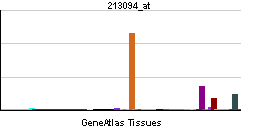GPR126
| G protein-coupled receptor 126 | |||||||||||
|---|---|---|---|---|---|---|---|---|---|---|---|
| Identifiers | |||||||||||
| Symbols | GPR126 ; DREG; PS1TP2; VIGR | ||||||||||
| External IDs | Template:MGI HomoloGene: 10724 | ||||||||||
| |||||||||||
| RNA expression pattern | |||||||||||
 | |||||||||||
| More reference expression data | |||||||||||
| Orthologs | |||||||||||
| Template:GNF Ortholog box | |||||||||||
| Species | Human | Mouse | |||||||||
| Entrez | n/a | n/a | |||||||||
| Ensembl | n/a | n/a | |||||||||
| UniProt | n/a | n/a | |||||||||
| RefSeq (mRNA) | n/a | n/a | |||||||||
| RefSeq (protein) | n/a | n/a | |||||||||
| Location (UCSC) | n/a | n/a | |||||||||
| PubMed search | n/a | n/a | |||||||||
G protein-coupled receptor 126, also known as GPR126, is a human gene.[1]
References
Further reading
- Matoba R, Okubo K, Hori N; et al. (1994). "The addition of 5'-coding information to a 3'-directed cDNA library improves analysis of gene expression". Gene. 146 (2): 199–207. PMID 8076819.
- Strausberg RL, Feingold EA, Grouse LH; et al. (2003). "Generation and initial analysis of more than 15,000 full-length human and mouse cDNA sequences". Proc. Natl. Acad. Sci. U.S.A. 99 (26): 16899–903. doi:10.1073/pnas.242603899. PMID 12477932.
- Fredriksson R, Gloriam DE, Höglund PJ; et al. (2003). "There exist at least 30 human G-protein-coupled receptors with long Ser/Thr-rich N-termini". Biochem. Biophys. Res. Commun. 301 (3): 725–34. PMID 12565841.
- Ota T, Suzuki Y, Nishikawa T; et al. (2004). "Complete sequencing and characterization of 21,243 full-length human cDNAs". Nat. Genet. 36 (1): 40–5. doi:10.1038/ng1285. PMID 14702039.
- Kristiansen TZ, Bunkenborg J, Gronborg M; et al. (2005). "A proteomic analysis of human bile". Mol. Cell Proteomics. 3 (7): 715–28. doi:10.1074/mcp.M400015-MCP200. PMID 15084671.
- Moriguchi T, Haraguchi K, Ueda N; et al. (2005). "DREG, a developmentally regulated G protein-coupled receptor containing two conserved proteolytic cleavage sites". Genes Cells. 9 (6): 549–60. doi:10.1111/j.1356-9597.2004.00743.x. PMID 15189448.
- Bjarnadóttir TK, Fredriksson R, Höglund PJ; et al. (2005). "The human and mouse repertoire of the adhesion family of G-protein-coupled receptors". Genomics. 84 (1): 23–33. doi:10.1016/j.ygeno.2003.12.004. PMID 15203201.
- Stehlik C, Kroismayr R, Dorfleutner A; et al. (2004). "VIGR--a novel inducible adhesion family G-protein coupled receptor in endothelial cells". FEBS Lett. 569 (1–3): 149–55. doi:10.1016/j.febslet.2004.05.038. PMID 15225624.
- Otsuki T, Ota T, Nishikawa T; et al. (2007). "Signal sequence and keyword trap in silico for selection of full-length human cDNAs encoding secretion or membrane proteins from oligo-capped cDNA libraries". DNA Res. 12 (2): 117–26. doi:10.1093/dnares/12.2.117. PMID 16303743.
- Liu T, Qian WJ, Gritsenko MA; et al. (2006). "Human plasma N-glycoproteome analysis by immunoaffinity subtraction, hydrazide chemistry, and mass spectrometry". J. Proteome Res. 4 (6): 2070–80. doi:10.1021/pr0502065. PMID 16335952.
| Stub icon | This membrane protein–related article is a stub. You can help Wikipedia by expanding it. |